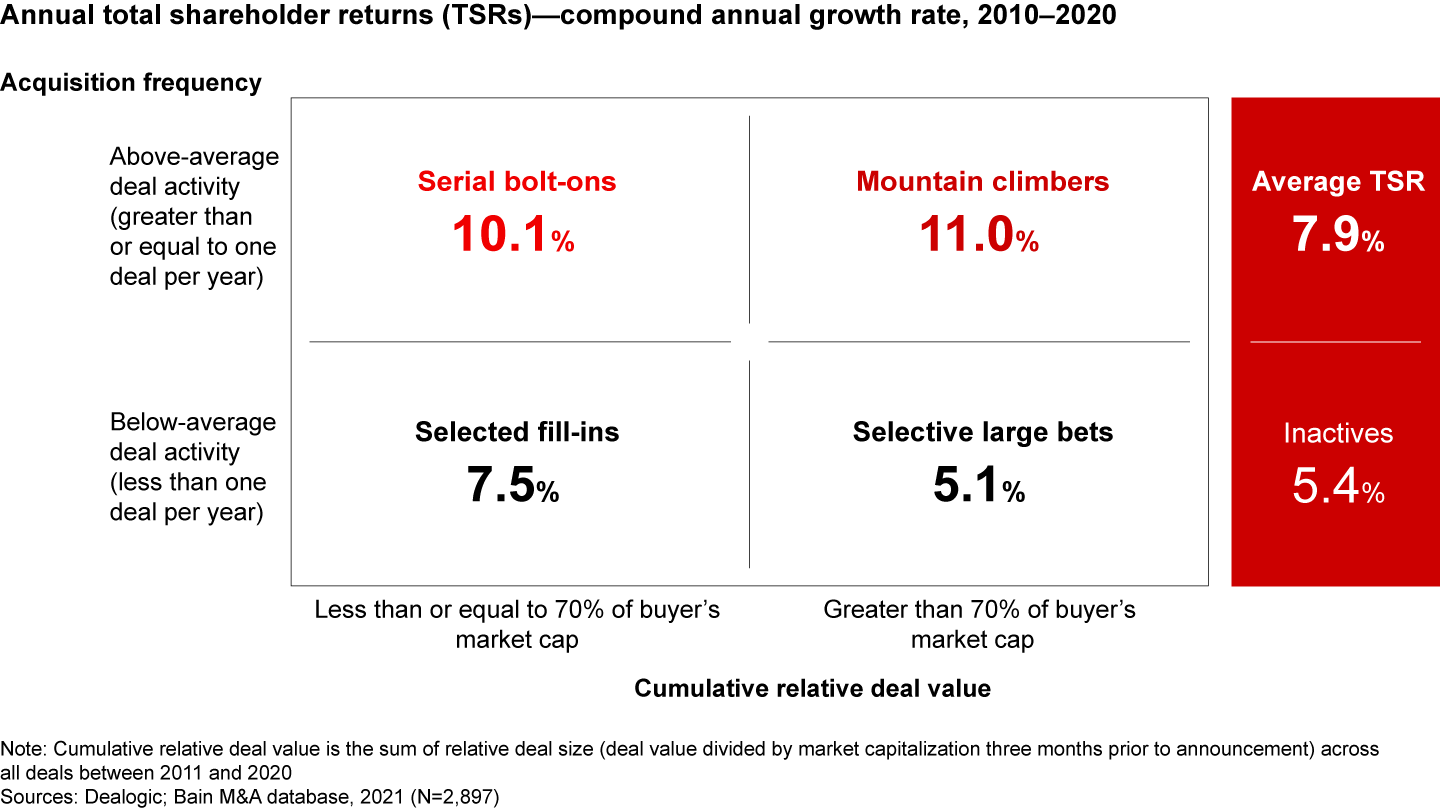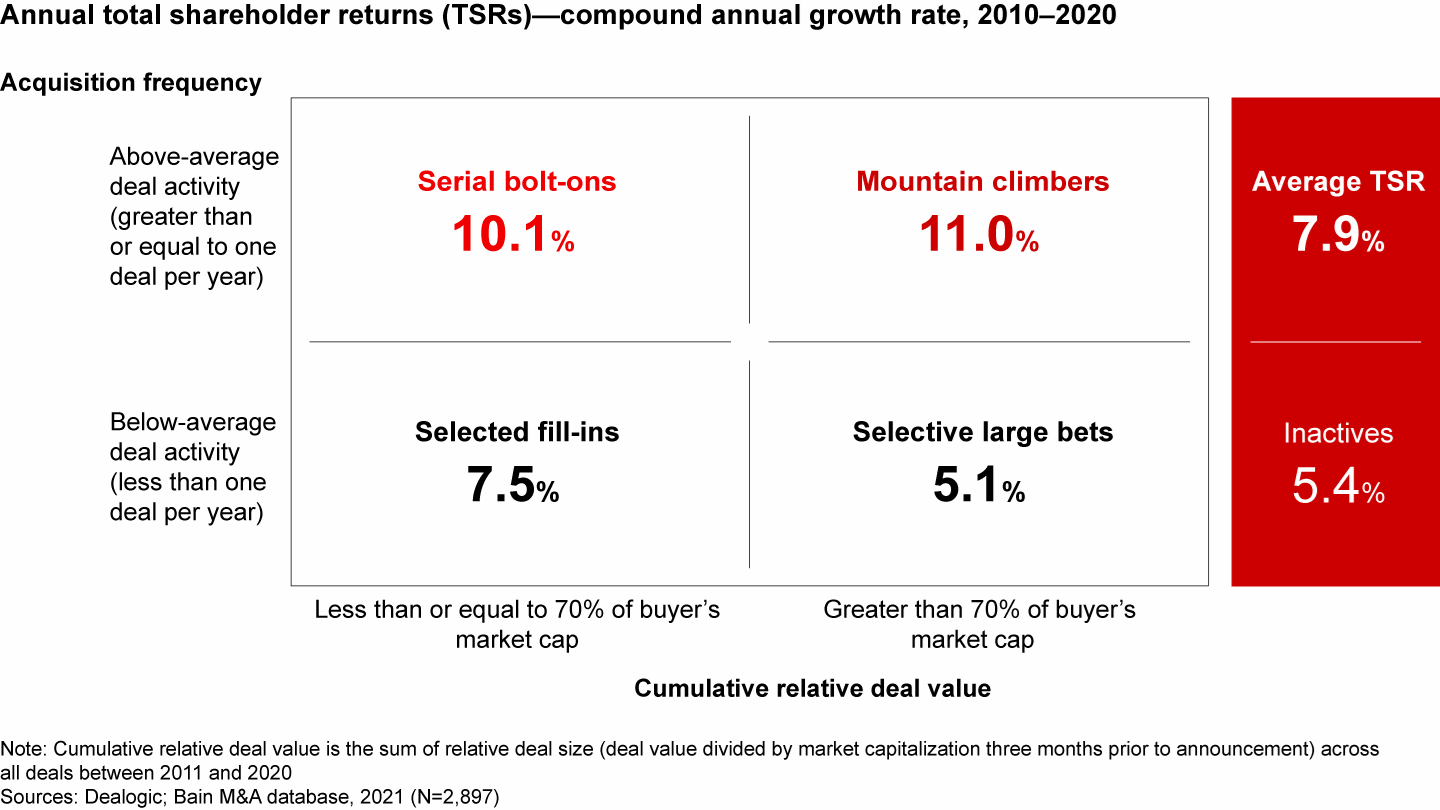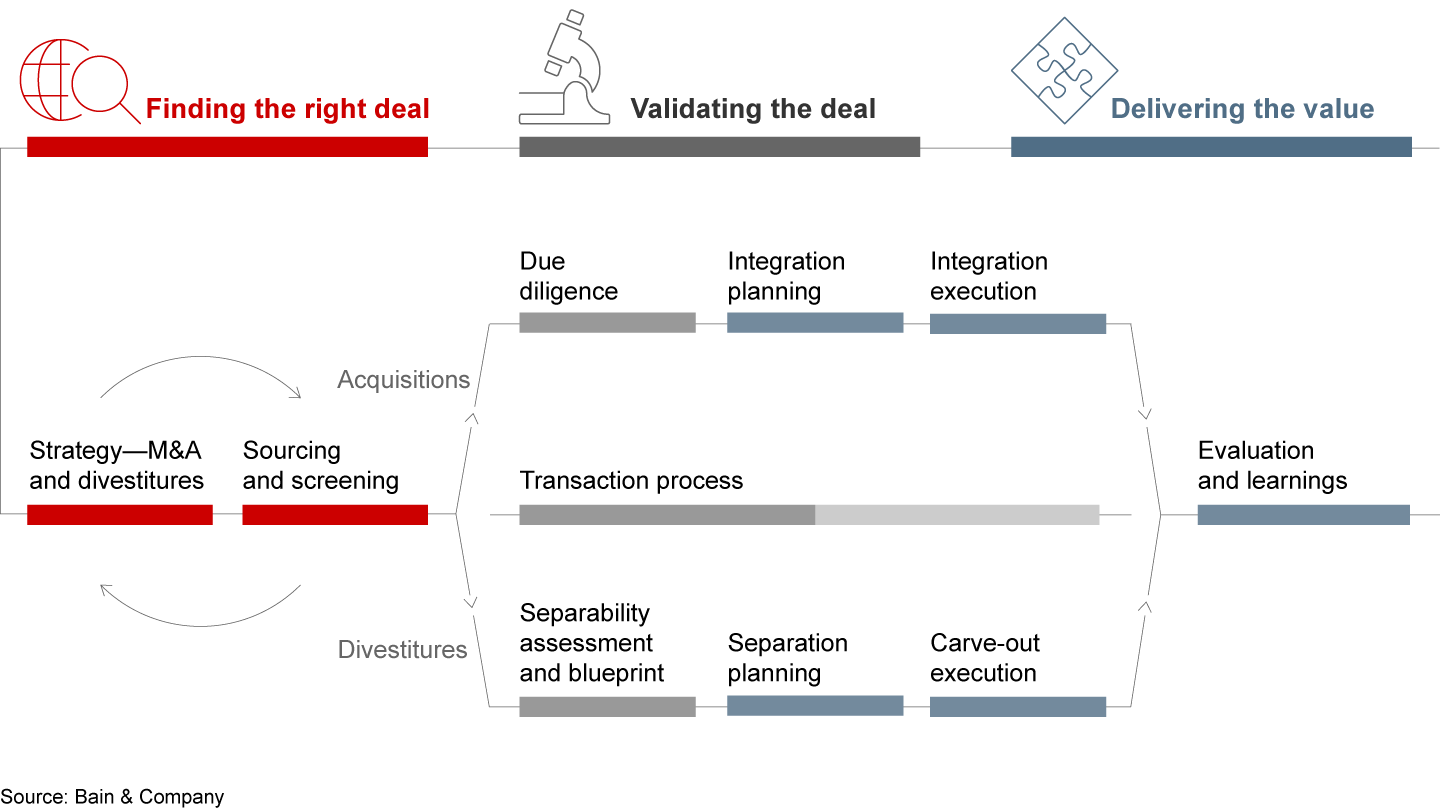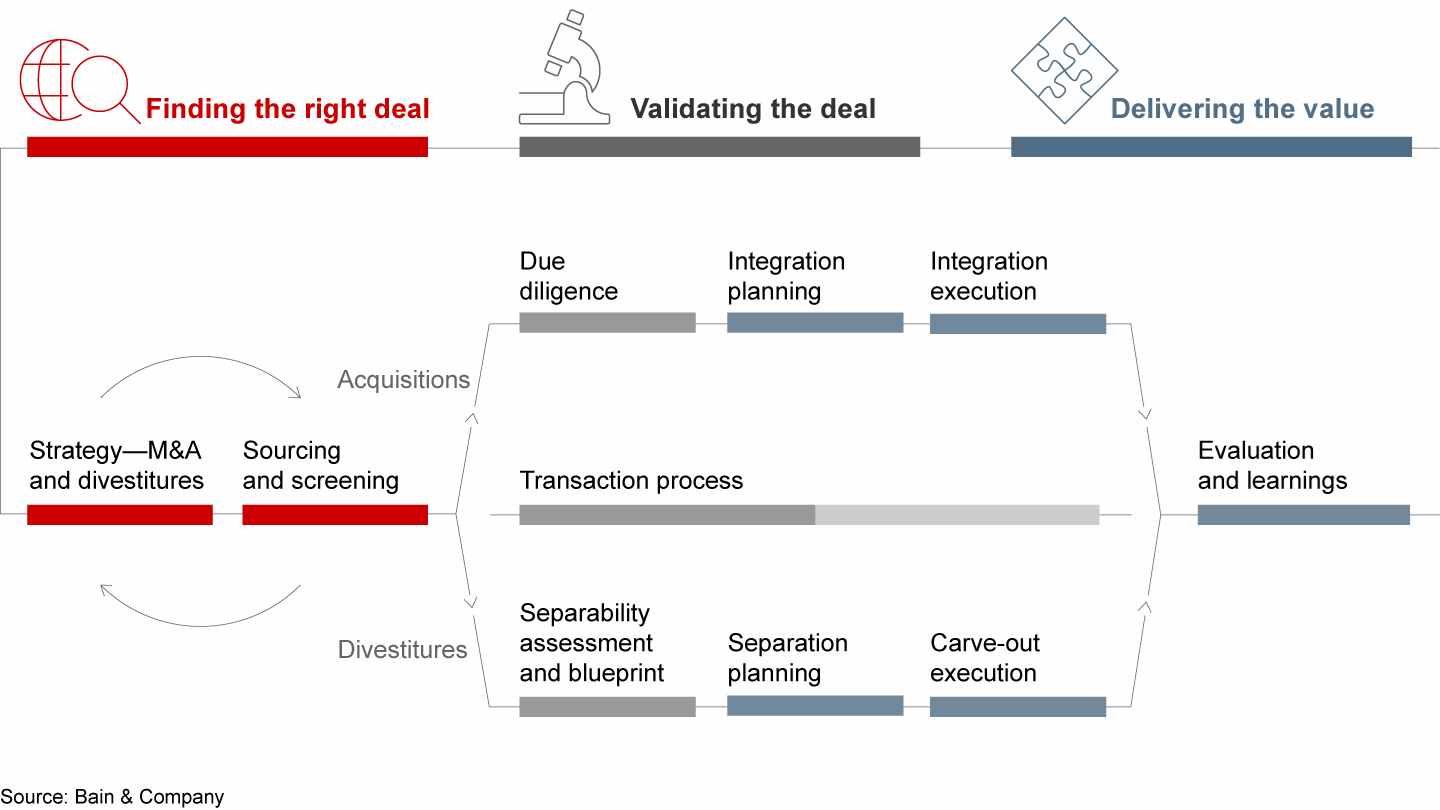M&A Report

This article is part of Bain's 2022 M&A Report.
This report necessarily spends most of its time on what is new and different in the world of M&A. For example, we have argued that executive teams need to modify their playbooks to retain critical talent; account for new business needs, such as environmental, social, and corporate governance; and capture revenue synergies.
All of that said, there are some fundamental truths about M&A that have withstood the test of time. The analyses discussed below have been replicated multiple times over the past 20 years. The answer remains the same across all the different cohorts we have studied.
Headline: If you want to be successful at M&A, develop a repeatable model. Do it often, learn from your mistakes, and make it a material part of your business. Done right, it will generate higher total shareholder returns (TSRs).
Fast fact: About 84% of publicly listed companies have participated in M&A over the past decade.
We have assessed the returns to shareholders of the different M&A strategies employed by a universe of 2,897 publicly traded companies from around the world.
It turns out that two axes define a lot of what differentiates M&A performance—frequency (how many deals you do) and materiality (how much of it you do). We have outlined the 10-year compound annual growth rates for the TSRs of four groups of acquirers by deal frequency and materiality. The 16% of companies that did no deals reported an annual TSR of 5.4% (see Figure 1).
Repeatable M&A is the winning strategy


It does not take a lot of deals to become a frequent acquirer, about one per year. To be a material acquirer does require heft—namely, 70% or more of your market cap from acquired companies over a decade. Still, 18% of all the companies in our sample were considered material acquirers.
So what do these trends tell us?
First, consistent M&A activity over economic cycles contributes to higher TSR. This finding holds up year after year, across industries. Deal success and deal failure is more a matter of cumulative experience and capability in making a deal and less a function of standalone deal circumstances.
Second, similar to most things in life, you get better at what you do when you do it repeatedly. Companies that acquire frequently (serial bolt-ons) tend to outperform the average company on TSR (10.1% annual).
Third, companies that not only acquire frequently but that also develop the capabilities to undertake larger deals do even better. We call these companies mountain climbers, and their 11.0% annual TSR leads the class. Investors have come to recognize this.
Consistent M&A activity over economic cycles contributes to higher total shareholder returns. This finding holds up year after year, across industries.
We spend a lot of time studying mountain climbers to understand their distinguishing capabilities. Two mountain climbers, Thermo Fisher Scientific and Hitachi, are highlighted in the following section. More broadly, we have identified and track 334 mountain climbers. Many are well-known success stories, including Ahold Delhaize, Alimentation Couche-Tard, Assa Abloy, Bristol-Myers Squibb, Broadcom, Charter Communications, Cigna, Melrose Industries, Qualcomm, Salesforce, Schneider Electric, Siemens, Sony, Stanley Black & Decker, Symrise, Toyota, Tyson Foods, UnitedHealth Group, and so on.
Mountain climbers follow an integrated approach to managing M&A from strategy to integration, which strengthens and reinforces their repeatable M&A capability with each deal (see Figure 2).
If done right, M&A creates value—especially with a repeatable model built upon a disciplined M&A capability


In addition to being frequent and substantial acquirers, mountain climbers also proactively manage their portfolios by pruning noncore businesses. It’s another big factor that contributes to their success. According to our analysis, more than 90% of mountain climbers divest, and the average mountain climber will divest about 27% of its market capitalization over a 10-year period. These companies deploy a repeatable process for systematically identifying assets for divestiture and preparing them for sale.
Another big learning from our study comes from the failure of companies that make infrequent, big bets. We refer to such companies as “selective large bets”: They are infrequent acquirers, but they undertake large deals relative to their market capitalization. Among all companies studied, these are the worst performers over time as their limited acquisition experience, combined with investment in a large deal, usually results in poor deal outcomes. They generated only 5.1% in annual TSR from 2010 to 2020.
Infrequent acquirers that undertake large deals relative to their market capitalization are the worst performers over time.
Going forward, an even higher premium will be placed on building a repeatable M&A capability that delivers successful outcomes across multiple deal types—small and large, scale and scope. The leap from small deals to large deals is a big one as is the one from scale deals to scope deals. We believe that the new wave of M&A—in particular, those involving capability-driven scope deals—will require a fundamentally different approach to realize the value. Companies will need to adapt and modify their diligence and integration playbooks as they pursue scope deals for growth and potentially more transformative, capability-driven scope deals.
The new wave of M&A—in particular, those involving capability-driven scope deals—will require a fundamentally different approach to realize the value.
What mountain climbers do differently
While every company will have a distinct strategy and M&A roadmap that accounts for its industry and competitive dynamics, we’ve distilled some of the practical actions mountain climbers take to underpin their repeatable M&A capability. What we have learned is that there is no silver bullet that guarantees success. Instead, we see the best rigorously applying learnings from past deals across the entire M&A process to increase their chance of success. Here we show two fairly distinct approaches that have powered two companies toward winning in their respective industries.
Thermo Fisher Scientific, a leading US biotechnology product development company, has brought together several acquisitions over the past 10 years to deliver a more than tenfold increase in its share price. Its M&A capability is widely recognized as a strong differentiator and a sustainable growth lever.
After experiencing an $8 billion loss in 2009, Japan’s Hitachi announced that it would shift away from its comprehensive electronics conglomerate portfolio. In 2015, Hitachi began restructuring its portfolio. To that end, the company acquired to fortify its new core, systematically divesting unrelated businesses to fund the acquisitions.
What drives Thermo Fisher Scientific’s repeatable M&A capability?
|
Finding the right deal |
|
|
Validating the deal |
|
|
Delivering the value |
|
What drives Hitachi’s repeatable M&A capability?
|
Finding the right deal |
|
|
Validating the deal |
|
|
Delivering the value |
|